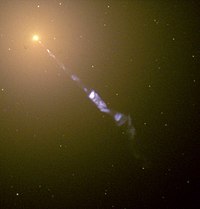
Photo from wikipedia
The physical properties of Epoch of Reionization (EoR) galaxies are still poorly constrained by observations. To better understand the ionizing properties of galaxies in the EoR, we investigate deep, rest-frame… Click to show full abstract
The physical properties of Epoch of Reionization (EoR) galaxies are still poorly constrained by observations. To better understand the ionizing properties of galaxies in the EoR, we investigate deep, rest-frame ultraviolet (UV) spectra of ≃ 500 star-forming galaxies at 3 ≤ z ≤ 5 selected from the public ESO-VANDELS spectroscopic survey. The absolute ionizing photon escape fraction ($f_{\rm esc}^{\rm abs}$, i.e. the ratio of leaking against produced ionizing photons) is derived by combining absorption line measurements with estimates of the UV attenuation. The ionizing production efficiency (ξion, i.e. the number of ionizing photons produced per non-ionizing UV luminosity) is calculated by fitting the far-UV (FUV) stellar continuum of the VANDELS galaxies. We find that the $f_{\rm esc}^{\rm abs}$ and ξion parameters increase towards low-mass, blue UV-continuum slopes and strong Lyα emitting galaxies, and both are slightly higher-than-average for the UV-faintest galaxies in the sample. Potential Lyman Continuum Emitters (LCEs, $f_{\rm esc}^{\rm abs} \ge 5{{\%}}$) and selected Lyman Alpha Emitters (LAEs, WLyα ≤ −20 Å) show systematically higher ξion (log ξion(Hz/erg) ≈ 25.38, 25.41) than non-LCEs and non-LAEs (log ξion(Hz/erg) ≈ 25.18, 25.14) at similar UV magnitudes. This indicates very young underlying stellar populations (≈10 Myr) at relatively low metallicities (≈0.2 Z⊙). The FUV non-ionizing spectra of potential LCEs is characterized by blue UV slopes (≤−2), enhanced Lyα emission (≤−25 Å), strong UV nebular lines (e.g. high ${\rm C\, \small {IV}}$1550/${\rm C\, \small {III}}$1908 ≥0.75 ratios), and weak absorption lines (≤1 Å). The latter suggests the existence of low gas-column-density channels in the interstellar medium, which enables the escape of ionizing photons. By comparing our VANDELS results against other surveys in the literature, our findings imply that the ionizing budget in the EoR was likely dominated by UV-faint, low-mass and dustless galaxies.
Journal Title: Monthly Notices of the Royal Astronomical Society
Year Published: 2022
Link to full text (if available)
Share on Social Media: Sign Up to like & get
recommendations!